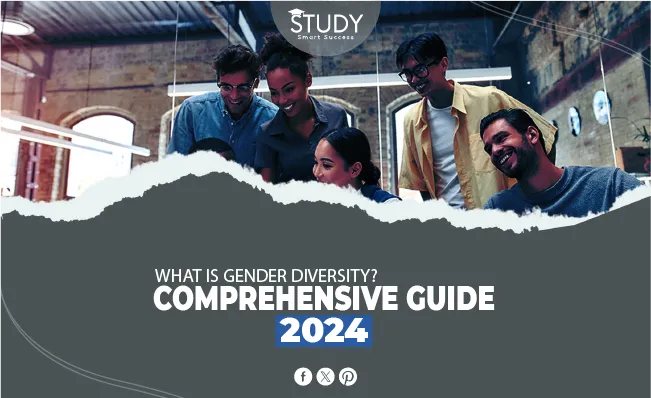Introduction
Our culture needs gender diversity awareness and acceptance. Tolerance, acceptance, festivity, and empowerment. This blog covers gender diversity’s definition, importance, issues, and inclusivity strategies. We’ll examine how gender diversity may benefit organizations, individuals, and communities from the boardroom to the classroom, workplace, and community. Enter gender inclusion with curiosity, empathy, and a drive for good change.
Read more details about Socioeconomic Diversity.
Definition of Gender Diversity
Beyond the simple ideas of male and female, gender diversity includes all the different identities people can have. It acknowledges that gender is a range and that everyone experiences and shows their gender uniquely.
Importance of Gender Diversity in Today’s Society
We cannot overstate the importance of gender diversity in today’s fast-changing world. Fairness and social justice are crucial, as are fresh ideas, corporate success, and welcoming communities. Accepting gender diversity helps everyone fulfill their potential and makes society more fair and lively.
Understanding Gender Diversity
Exploring Gender as a Spectrum
Gender goes beyond male and female. Instead, it encompasses a variety of identities beyond standard definitions. This spectrum covers transgender, non-binary, genderqueer, a gender, and others. Gender experiences are personal and valid, reflecting self-perception rather than social conventions.
Breaking down Gender Stereotypes
Society’s gender stereotypes and expectations perpetuate damaging ideas and limit people’s freedom to express themselves. Challenge and dismantle these assumptions to allow all genders to thrive without judgment or discrimination. Gender stereotypes must be broken to promote inclusivity and individuality.
Recognizing the Intersectionality of Gender with Other Identities
Gendered identity overlaps with race, ethnicity, sexuality, class, and ability. Intersectionality affects people’s lives and worldviews. Cultural, social, and handicap status might affect gender experience. Promoting fully inclusive places that recognize and respect all aspects of a person’s identity requires recognizing and comprehending these intersections.
The Benefits of Gender Diversity
Fostering Innovation and Creativity
Gender diversity unites people with diverse viewpoints, experiences, and ideas. Diverse gender perspectives stimulate creativity and innovation when they collaborate. Research shows that diverse teams are more likely to innovate and make better decisions, giving them an edge in today’s fast-changing corporate environment.
Enhancing Organizational Performance
Gender diversity-focused companies outperform others in key measures. By maximizing their talent, diverse teams may boost productivity, problem-solving, and profits. Varied firms can better understand and address the demands of varied customers, resulting in market success and long-term sustainability.
Improving Workplace Culture and Morale
An inclusive workplace that embraces gender diversity fosters employee belonging and acceptance. When people feel appreciated and respected, they are more engaged, motivated, and fulfilled in their jobs. Positive work environments improve employee retention, turnover, and morale. Diverse teams also have better teamwork, communication, and collaboration, providing a supportive and cohesive workplace.
Challenges and Barriers
Gender Bias and Discrimination
Despite progress toward gender equality, overt and subtle gender bias and discrimination exist. Women, non-binary people, and transgender people encounter preconceptions, prejudices, and systematic impediments to achievement. To combat gender bias and discrimination, we must challenge stereotypes, promote equality, and build inclusive workplaces where everyone may thrive.
Lack of Representation in Leadership Roles
Women, non-binary people, and other marginalized genders are underrepresented in leadership, making gender diversity challenging. Glass ceilings, unconscious biases, and structural barriers hinder them from becoming leaders, perpetuating gender inequality in business and society. Diversity in recruitment, leadership development, and succession planning is needed to overcome these challenges.
Addressing Unconscious Bias
Stereotypes and prejudices that affect our thoughts, feelings, and actions without our awareness are called unconscious bias. These biases can result in inequality and exclusion in recruiting, promotion, performance evaluations, and other organizational areas. Unconscious prejudice can be mitigated by raising awareness, training, and implementing rules and procedures that promote justice and equity.
Strategies for Promoting Gender Diversity
Implementing Inclusive Hiring Practices
Gender diversity requires inclusive recruiting strategies prioritizing merit, talents, and potential over gender preconceptions. These strategies include blind recruitment, bias-free job descriptions, and diverse candidate pools. Fostering ties with various talent streams and actively recruiting underrepresented groups can also increase candidate diversity and encourage diversity across the organization.
Providing Diversity and Inclusion Training
Education and awareness are crucial to workplace gender diversity. Comprehensive diversity and inclusion training for all employees raises awareness of unconscious biases, fosters empathy and understanding, and equips people to create inclusive settings.
To empower employees to fight discrimination and promote diversity, training should encompass gender identity and expression, cultural competency, and bystander intervention.
Creating Supportive Policies and Initiatives
Organizations must create and implement gender diversity and inclusion policies and activities throughout the workplace. It includes fair pay, family leave, flexible work, and anti-discrimination regulations.
Employee resource organizations, mentorship programs, and affinity networks can help varied gender groups network and advance their careers. Inclusion and belonging can help organizations create an environment where everyone can thrive and offer their best.
Future Trends and Outlook
Emerging Trends in Gender Diversity and Inclusion
Gender diversity and inclusion trends change with society. Emerging trends may include rising awareness of non-binary and gender non-conforming identities, activism for transgender rights and healthcare access, and intersectional diversity and inclusion activities.
New technologies and remote employment may offer new chances to promote inclusivity and accommodate varied gender identities in virtual spaces.
Predictions for the Future of Workplace Equality
The future of workplace equality is promising but challenging. Expect more women and disadvantaged genders in leadership roles, better transparency and accountability for diversity indicators and programs, and continuing efforts to remove systemic barriers and biases.
Organizations, policymakers, and individuals must work together to eliminate structural inequities and promote equal opportunities for all to achieve workplace equality.
How Individuals and Organizations Can Contribute
Individuals and organizations must act to advance gender diversity and inclusion. Gender diversity education, challenging assumptions and biases, and advocating for inclusive workplaces and communities are all possible.
Organizations may make diversity and inclusion strategic, invest in training and resources for varied gender staff, and actively promote inclusive workplaces where everyone feels valued and appreciated. We can build a future where gender diversity is respected, and everyone thrives by working together.
Conclusion
This investigation of gender variety has studied its definition as a spectrum of identities beyond binaries. We have stressed breaking gender stereotypes, acknowledging intersectionality, and addressing barriers to inclusivity. We’ve also examined gender diversity initiatives, future trends, and how individuals and organizations may make positive changes.
Finally, I urge you to act in your domains of influence. You can influence workplace change as an individual or as a leader. Promote diversity, inclusion, and stereotype-busting in your community. We can build a world where gender diversity is respected and everyone thrives, regardless of gender identity or presentation.


